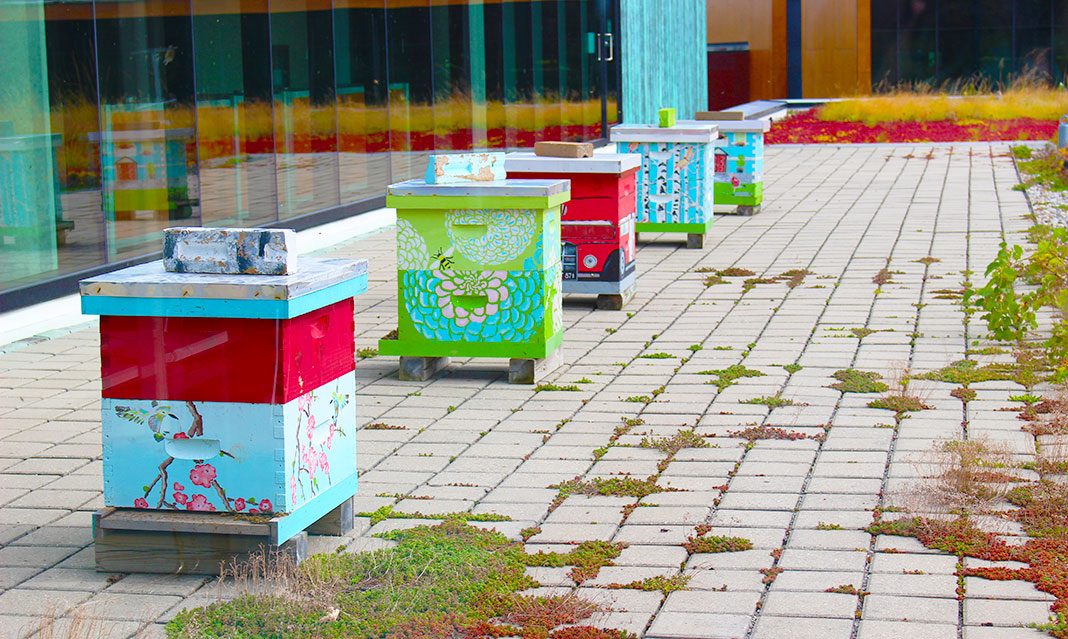One of UTM’s most unique aspects is its apiary program. This summer, there were about 250,000 bees living on the roof of the Instructional Centre building. Andrea De Vito, Assistant Director of Retail Services & Administration, describes the beehives and the purpose of the program to The Medium for this issue.
As De Vito states, “the apiary program started at UTM in mid-2017” with three beehives located on the green roof of the Instructional Centre building and 15,000 bees. The number increased to five beehives this year, with each hive housing around 50,000 bees in the summer. The bee population decreases in the fall and winter seasons and there are around 5,000 bees per hive “in early spring, coming out of winter.”
For those scared of bees, the bees living on campus are Buckfast bees. As the Hospitality & Retail Services website details, Buckfast bees “are an English-bred strain that is resistant to parasites and mites, and are known for being very calm and non-aggressive.” The five beehives themselves were painted by artist Vitalia Smirnova and are named “KoBee, Sting, Queen Latifah, Bee-Yonce, and Chubee.”
Don Forster, a registered beekeeper, “maintains and harvests the honey for UTM. Don is responsible for preparing bees and equipment for pollination activities, cleaning and constructing hives, raising and replacing queen bees, dividing colonies when necessary, and replacing combs. He also inspects the hives to see if they are healthy and absent from any diseases.” Since bees “may require pollen packs (bee food)” just after the winter season, Forester is responsible for feeding the bees as well.
The Hospitality & Retail Services’ Sustainability and Social Responsibility Initiative inspired the creation of the apiary program at UTM. “Bee populations have declined due to pesticide use, loss of habitat, and Bee Colony Collapse Disorder,” explains De Vito. According to the National Pesticide Information Centre, Colony Collapse Disorder is when the majority of adult honeybees all abandon the hives at the same time. Only the queen bee and the immature bees remain in the hive with “plenty of food stores.”
Fortunately, De Vito says that the “abundance of nature on [the UTM] campus allows for an ideal location for bees to thrive.” The UTM apiary helps “combat CCD and helps the local environment by introducing the bees to pollinate gardens in the area.” The program also “helps decrease waste” as UTM no longer has to purchase pre-packaged honey.
This year, “approximately 460 kilograms (~1,000 pounds) of honey was harvested.” Some of the honey is sold to “Chartwells to be used in recipes for food products made available for sale at UTM. Hospitality & Retail Services does not make any profit from the sale of honey; proceeds from the sale of honey are used to maintain the apiary program.”
If students are interested in purchasing honey harvested at UTM, they can purchase it from the Hospitality & Retail Services Office (DV3127) while supplies last. A 250 grams container of honey costs $7; 500 grams costs $13; and one kilogram of honey $18. As stated on the Hospitality & Retail Services website, the honey “is truly a limited edition each time” as the flavor differs each season “based on which plants and flowers are in bloom.”
The beehives can be viewed from the windows on the third floor of the Instructional Centre building. Beekeeper Forester will also “be onsite at the Instructional Centre on October 10 at 4 p.m. (weather permitting) to check on the bees” which will be a great “opportunity to see bee-keeping at work” for those who are interested.



